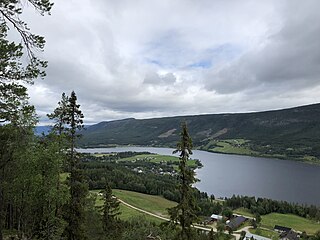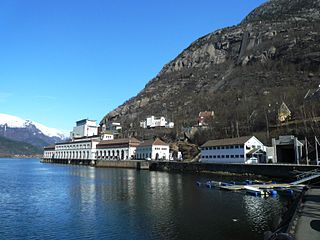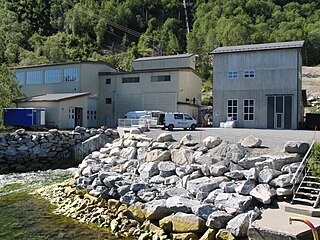The following page lists some power stations in Norway . Norway produces a total of 13,570 MW for power consumption. For traction current, see Electric power supply system of railways in Norway.
| Station | Location | Co-ordinates | Capacity (MW) | Type | Status |
|---|---|---|---|---|---|
| Mongstad Power Station | Mongstad | 60°48′32″N5°2′13″E / 60.80889°N 5.03694°E | 280 | Natural Gas | The plant was supposed to be closed at the end of 2018, but still in operation as of 2021. [4] |
| Tjeldbergodden Reserve Power Station | Tjeldbergodden | 63°24′44″N8°41′12″E / 63.41222°N 8.68667°E | 150 | Natural Gas | Not in Use |

Hydroelectricity, or hydroelectric power, is electricity generated from hydropower. Hydropower supplies one sixth of the world's electricity, almost 4500 TWh in 2020, which is more than all other renewable sources combined and also more than nuclear power. Hydropower can provide large amounts of low-carbon electricity on demand, making it a key element for creating secure and clean electricity supply systems. A hydroelectric power station that has a dam and reservoir is a flexible source, since the amount of electricity produced can be increased or decreased in seconds or minutes in response to varying electricity demand. Once a hydroelectric complex is constructed, it produces no direct waste, and almost always emits considerably less greenhouse gas than fossil fuel-powered energy plants. However, when constructed in lowland rainforest areas, where part of the forest is inundated, substantial amounts of greenhouse gases may be emitted.

The electricity sector in Norway relies predominantly on hydroelectricity. A significant share of the total electrical production is consumed by national industry.

The Norwegian Water Resources and Energy Directorate is a Norwegian government agency established in 1921. It is under the Ministry of Petroleum and Energy and regulates the country's water resources and energy supply. Its mandate includes contingency planning for floods, serving as a centre of expertise for hydrology, research and development, and increasing energy efficiency. It is a member of the Council of European Energy Regulators.
Holmvatnet is a lake and a reservoir in the municipality of Rana in Nordland county, Norway. It is located northeast of the villages of Mæla and Myklebustad.
Statkraft AS is a hydropower company, fully owned by the Norwegian state. The Statkraft Group is Europe's largest generator of renewable energy, as well as Norway’s largest and the Nordic region's third largest energy producer. Statkraft develops and generates hydropower, wind power, gas power, district heating and solar power, and is also a player in the international energy markets. The company has 5300 employees in 21 countries with their headquarters located in Oslo, Norway.

The Minister of Energy is a councilor of state and chief of the Norway's Ministry of Petroleum and Energy. The current minister is Terje Aasland. The ministry is responsible for the government's energy policy, including management of Norway's energy resources, including the valuable deposits of petroleum and hydroelectricity. Major subordinate agencies and companies include the Water Resources and Energy Directorate, the Petroleum Directorate, Petoro, Gassnova, Gassco, Enova, Statnett and a partial ownership of Statoil. The position was created on 11 January 1978 as a response to the increased importance of oil on the Norwegian continental shelf. The position was merged with the Minister of Trade and Industry between 1992 and 1996. It was renamed Minister of Energy starting from 1 January 2024.

Lomnessjøen is a lake in Rendalen Municipality in Innlandet county, Norway. The villages Åkre and Otnes are located on the shores of the lake. The lake is part of the Renaelva river system. The Renaelva river flows into the lake from the north. The south end of the river drains into the larger lake Storsjøen which is about 3 kilometres (1.9 mi) to the south of this lake.
Innerdalsvatnet is a lake in Tynset Municipality in Innlandet county, Norway. It is a significant part of the Orkla watershed. The 5.88-square-kilometre (2.27 sq mi) lake lies about 10 kilometres (6.2 mi) west of the village of Yset. The northwest end of the lake has a large dam on it to control the level of the water for hydropower. The dam is actually located on the municipal and county border. The lake holds about 150,000,000 cubic metres (4.0×1010 US gal) of water which is run through a long tunnel to two nearby power stations.
Marsjøen is a lake in Folldal Municipality in Innlandet county, Norway. The 2.64-square-kilometre (1.02 sq mi) lake lies in the northern part of the municipality, about 7 kilometres (4.3 mi) east of the larger lake Fundin. There is a dam at the south end of the lake which is used to regulate the water height for use in the nearby Einunna and Savalen hydro-electric power stations.

Naturkraft is a Norwegian power company that operates one natural gas powered thermal power station located at Kårstø. It also holds a permit to build a second one at Kollsnes. The company is owned by Statoil and Statkraft, with 50% each.

Tjeldbergodden Reserve Power Station is a natural gas-fired thermal power plant located at the industrial site Tjeldbergodden in the northeastern part of the municipality of Aure in Møre og Romsdal county, Norway. It is operated by Statnett. The station has installed one gas turbine with 150 megawatts (200,000 hp) effect. The power station was installed in 2006, but by 2015 it had not been in use. Together with the similar power plant at Nyhamna, they cost 2.1 billion NOK. A new power line has made them unnecessary.
The Royal Norwegian Ministry of Petroleum and Energy is a Norwegian ministry responsible for energy, including petroleum and natural gas production in the North Sea. It is led by Minister of Petroleum and Energy Terje Aasland of the Labour Party since 2022. The department must report to the legislature, the Storting.
The Meghri hydroelectric project is a hydroelectric project planned on the Aras River near Armenia's southern town of Meghri on the Armenia–Iran border.

Norway is a heavy producer of renewable energy because of hydropower. Over 99% of the electricity production in mainland Norway is from 31 GW hydropower plants. The average hydropower is 133 TWh/year. There is also a large potential in wind power, offshore wind power and wave power, as well as production of bio-energy from wood. Norway has limited resources in solar energy, but is one of the world's largest producers of solar grade silicon and silicon solar cells.

Kraftverkene i Øvre Namsen or KØN was a joint venture between the Norwegian Water Resources and Energy Directorate (NVE) and Nord-Trøndelag Elektrisitetsverk (NTE). The venture started in 1958 and consisted of three wholly owned hydroelectric power stations in Norway and a partial ownership in one power station in Sweden, which opened between 1962 and 1965. With the establishment of Statkraft, the NVE's shares were transferred there. In 2004, NTE bought Statkraft's share, and the power production was incorporated into NTE's operations.

The United Kingdom has a National Grid that covers most of mainland Great Britain and several of the surrounding islands, as well as some connectivity to other countries. The electrical sector supplies power to consumers at 230 volts AC with a frequency of 50 Hz. In 2020 the electricity sector's grid supply came from 55% low-carbon power, 36.1% fossil fuelled power, and 8.4% imports. Renewable power is showing strong growth, while fossil fuel generator use in general and coal use in particular is shrinking, with historically dominant coal generators now mainly being run in winter due to pollution and costs, and contributed just 1.6% of the supply in 2020.

The Tyssedal Power Station is a hydroelectric power station and museum located in Tyssedal in the municipality Odda in Vestland, Norway. The station was designed by architect Thorvald Astrup. It started production in 1906 and operated at a combined installed capacity of 100 MW from 1918, with an average annual production of 700 GWh. The plant was protected by the Norwegian Directorate for Cultural Heritage in 2000, and is part of the Norwegian Museum of Hydropower and Industry. The power station was added to the list of priority technical and industrial cultural heritage by the Norwegian Directorate for Cultural Heritage.
The Güllübağ Dam is a gravity dam near the town of Güllübağ on the Çoruh River in Erzurum Province, Turkey. The primary purpose of the dam is hydroelectric power production. Construction on the river diversion tunnel began in 2009 and the dam was complete in 2012. That same year the first generator became operational and the final generator was operational in March 2013. Water from the dam is sent down downstream through a 3,200 m (10,500 ft) long penstock where it reaches an 84 MW power station. The dam is part of the Çoruh Development Plan and it is owned by Turkey's State Hydraulic Works.

The Oldereid Hydroelectric Power Station is a hydroelectric power station in Misvær in Nordland county, Norway.
Snarumselva is a river in Buskerud county, Norway. It flows north to south from Krøderen, a lake in Krødsherad municipality, to Geithus, a village in Modum municipality, where it joins the Drammenselva river. The total length of Snarumselva is about 50 km (31 mi) and the total altitude loss is about 100 m (330 ft).
{{cite web}}: CS1 maint: archived copy as title (link)